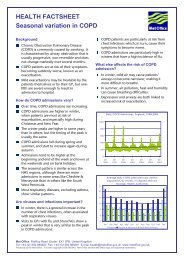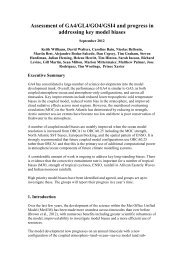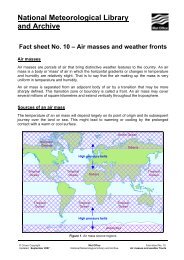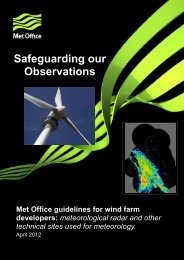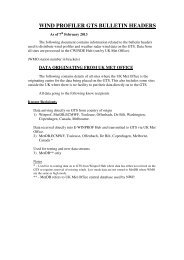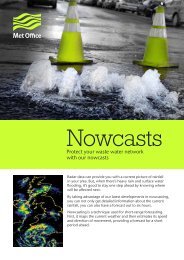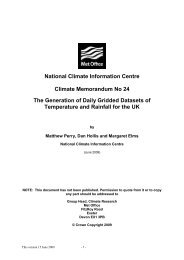Description and assessment of the OSTIA reanalysis. - Met Office
Description and assessment of the OSTIA reanalysis. - Met Office
Description and assessment of the OSTIA reanalysis. - Met Office
You also want an ePaper? Increase the reach of your titles
YUMPU automatically turns print PDFs into web optimized ePapers that Google loves.
y a factor which increases linearly from 1 at 1200 UTC on <strong>the</strong> analysis day to 1.5 at plus/minus<br />
36 hours. The magnitude <strong>of</strong> <strong>the</strong> scaling required was estimated by assuming that observation<br />
errors propagate with ocean features, thus <strong>the</strong> temporal correlations in <strong>the</strong> observation error can be<br />
obtained by calculating <strong>the</strong> temporal correlations in <strong>the</strong> SST’s or in SST anomalies (which removes<br />
<strong>the</strong> seasonal cycle from <strong>the</strong> correlations). A linear fit to <strong>the</strong> SST <strong>and</strong> SST anomaly correlations<br />
resulted in scaling factors <strong>of</strong> 1.3 <strong>and</strong> 1.7 respectively. Analysis <strong>of</strong> <strong>the</strong> impact <strong>of</strong> <strong>the</strong> different scaling<br />
factors on <strong>the</strong> analysis increments <strong>and</strong> observation minus background fields resulted in <strong>the</strong> mid-way<br />
value <strong>of</strong> 1.5 being chosen.<br />
3.6 Error estimation<br />
Each SST analysis is accompanied by an uncertainty estimate in <strong>the</strong> form <strong>of</strong> <strong>the</strong> estimated error<br />
st<strong>and</strong>ard deviation <strong>of</strong> <strong>the</strong> analysed SST. Computing <strong>the</strong> analysis error within <strong>the</strong> optimal interpolation<br />
scheme requires much more computational resources than <strong>the</strong> analysis itself so a simpler<br />
approach is used to estimate <strong>the</strong> analysis error. This is carried out in <strong>the</strong> <strong>OSTIA</strong> system using an<br />
analysis quality (AQ) optimal interpolation, as described in (Donlon et al., 2011).<br />
The analysis error is calculated by carrying out a second optimal interpolation identical to that<br />
described in section 3.5 except all observations are given a value <strong>of</strong> 1.0, <strong>the</strong> background is set to 0<br />
<strong>and</strong> <strong>the</strong> background <strong>and</strong> observation errors are <strong>the</strong> same as those used in <strong>the</strong> SST analysis. New<br />
observations add information to <strong>the</strong> AQ field <strong>and</strong> observation gaps result in <strong>the</strong> field decaying. The<br />
analysis error field provides information on <strong>the</strong> data coverage <strong>and</strong> observation errors that have been<br />
input into a given analysis plus information on <strong>the</strong> analysis background errors.<br />
© c Crown Copyright 2011 35




